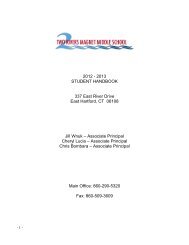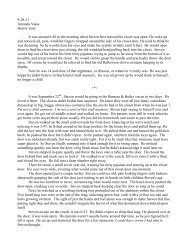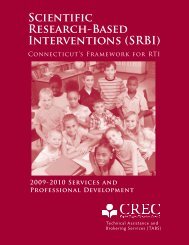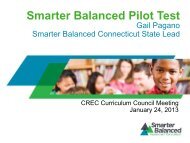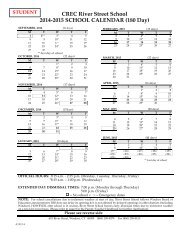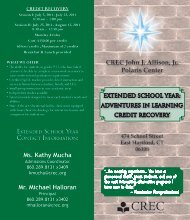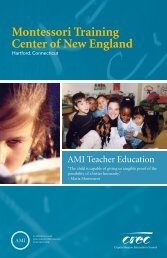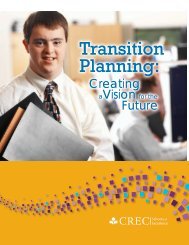Reading and Role Playing: Fiction, Folktales, and Fairy Tale
Reading and Role Playing: Fiction, Folktales, and Fairy Tale
Reading and Role Playing: Fiction, Folktales, and Fairy Tale
Create successful ePaper yourself
Turn your PDF publications into a flip-book with our unique Google optimized e-Paper software.
<strong>Reading</strong> Curricular Calendar, Second Grade, 2012-201313Continue to read these tales aloud to your students, perhaps spotlighting ones that convey lessonssimilar to ones children have encountered in the fiction books they’ve read. You can ask childrento think about how different authors convey the same lesson or how different authors haveopposite views about something. Many children’s books mirror these old tales, so it could be funfor you <strong>and</strong> the class to make bins of old <strong>and</strong> new books that go together. If you have multipleversions of Cinderella told by writers from around the world, those might all go into the samebin. Modern versions (Cinder Edna, Cinder-Elly) might go in that bin too, as could modern-daytakes on the story. Children will enjoy thinking across the differences amongst these tales, <strong>and</strong>will of course also meet CCSS RL 2.9. Have fun with these groupings but don’t force them. Ifyou <strong>and</strong> your kids don’t find ways to match new books with traditional tales, come up with newcategories: “books about friends that help each other” or “books about kids who save the day.”Children can also create book baskets based on the lessons <strong>and</strong> morals books convey They c<strong>and</strong>iscuss how books with similar lessons are the same <strong>and</strong> different (CCSS RL 2.2). Club matescan then work together to challenge one another’s category choices <strong>and</strong> consider other basketsthat might be more appropriate. Club mates can defend their ideas based on the evidence theyhave gathered in their books. They can also entice each other to read the book <strong>and</strong> the evidenceof a suggested theme or moral. They will monitor <strong>and</strong> question each other, saying things like,“Why do you think it should go there?” or “Did you ever think maybe it is really about ____?”You might want to read some fables aloud <strong>and</strong> ask children what they think the author wants thereader to learn. Don’t include the little spelled-out moral at the end. Instead, have children turn<strong>and</strong> talk or work as a class to guess the author’s intent. Arnold Lobel’s Fables is full of fun, kidfriendlytakes on old (sometimes stale) tales. Fables often offer two differing approaches to life,so they are a perfect vehicle for teaching children to think about various points of view,something the Common Core State St<strong>and</strong>ards emphasizes for second graders. For example, itmight be fun for the class to have a debate in which half the room takes the viewpoint of thetortoise, the other half, the hare. You can ask children to think about why a particular characterlooks at things one way <strong>and</strong> then defend that character’s viewpoint. Because fables are short,children might also put on little skits in which they bring out the points of view of the charactersthrough drama. Not only is this fun, it also sets children up to “acknowledge differences in thepoints of view of characters, including by speaking in a different voice for each character whenreading dialogue aloud” (CCSS RL 2.6).After hearing you read many of these tales <strong>and</strong> reading many others on their own, readers willprobably notice that a number of folktales <strong>and</strong> fairy tales have similarities: good triumphs overevil, selfish or lazy characters learn a lesson. Tell children that many authors of folktales <strong>and</strong>fairy tales intended their stories to convey a specific moral or a lesson. In The Three Little Pigswe learn that anything worth doing is worth doing well, <strong>and</strong> in Little Red Riding Hood we mightlearn not to follow or listen to strangers. Sometimes the message is highlighted at the end. Thestory may state, “The moral of this story is ____.” Other times readers need to determine itourselves. Either way, we will have to interpret the lesson the character learns or interpret whatlesson the author is trying to teach us. Readers can ask ourselves, “What is the author trying toteach me?” or “What lesson did the character learn?” or “How <strong>and</strong> why did the characterchange?” We can use what we have learned about the character <strong>and</strong> think about how theUnit Six – <strong>Reading</strong> <strong>and</strong> <strong>Role</strong> <strong>Playing</strong>: <strong>Fiction</strong>, <strong>Folktales</strong>, <strong>and</strong> <strong>Fairy</strong> <strong>Tale</strong>s<strong>Reading</strong> <strong>and</strong> Writing Project, 2012 ©DRAFT




